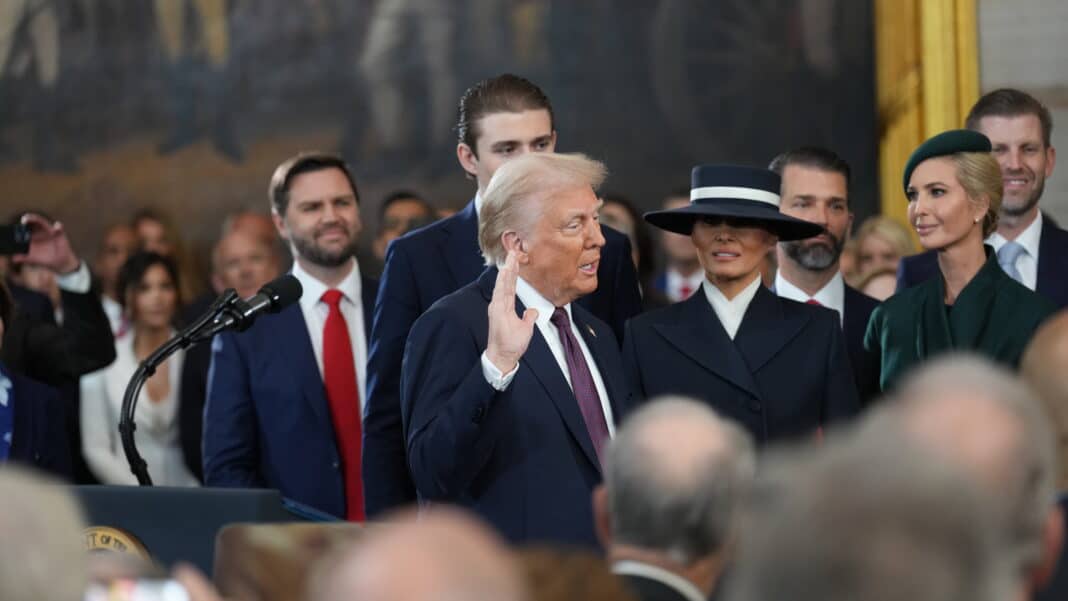Donald Trump’s inauguration on January 20, 2025, marked a most important moment in American history. This rare occasion coincided with Martin Luther King Jr. Day, making Trump only the third president to take the oath on this holiday. After facing multiple challenges that included impeachments and criminal indictments, Trump took his oath from Chief Justice John Roberts and became the 47th President of the United States.
“The golden age of America begins right now,” Trump declared in his inaugural address, which set the tone for his second term. His immediate agenda included signing executive orders about immigration and economic policies. He also planned to declare a national emergency at the southern border. The day ended with a milestone as the Senate confirmed Marco Rubio as Secretary of State, marking Trump’s first Cabinet appointment in his new administration.
Historic Return to White House
Donald Trump made history by becoming the second president in American history to reclaim the White House after an electoral defeat, joining Grover Cleveland who did this in 1892. This remarkable achievement stands as the first of its kind in more than 130 years, cementing Trump’s unique place in presidential history.
Trump’s return to power aligned with Martin Luther King Jr. Day, making it just the third time a president has taken the oath of office on this federal holiday. This rare timing created a special atmosphere in Washington DC. People celebrated both events at the same time, with Reverend Al Sharpton speaking at the Metropolitan African Methodist Episcopal church while inauguration ceremonies took place at the Capitol.
America’s tradition of peaceful power transfer, which has amazed the world throughout its history, stayed strong. Democratic Senator Amy Klobuchar, who chairs the joint congressional inaugural committee, gave opening remarks that highlighted “our enduring democracy”.
The day followed time-honored customs, starting with the president arriving at the Capitol. The cold weather forced officials to move the ceremony indoors, but thousands of excited supporters still gathered in Washington, D.C.. The celebrations ended with the traditional parade on Pennsylvania Avenue, following a custom that Thomas Jefferson started at his second inauguration in 1805.
Trump Arrives for Swearing-In Ceremony
Chief Justice John Roberts administered the presidential oath to Donald Trump inside the Capitol Rotunda as the clock struck noon Eastern time. The historic setting hosted a presidential oath-taking for only the second time after officials moved the ceremony indoors due to frigid weather.
The Lincoln Bible remained Trump’s choice for his swearing-in, along with a personal Bible his mother gave him in 1955. Trump created an unprecedented moment when he raised his right hand to recite the 35-word oath but did not place his left hand on the Bibles that First Lady Melania Trump held.
Senator Amy Klobuchar launched the ceremony with opening remarks that highlighted “our enduring democracy”. Vice President JD Vance took his oath first, which Supreme Court Associate Justice Brett Kavanaugh administered while Vance’s wife Usha held the Bible.
Tech industry leaders filled the Capitol Rotunda’s exclusive seating areas near Trump’s cabinet. Meta CEO Mark Zuckerberg, Amazon founder Jeff Bezos, and Tesla CEO Elon Musk, who has become Trump’s close adviser, attended the ceremony. The international presence included Chinese Vice-President Han Zheng, Argentina’s President Javier Milei, and Italy’s Prime Minister Giorgia Meloni.
The ceremony brought together former presidents Bill Clinton, George W. Bush, and Barack Obama, who upheld the tradition of peaceful transition. President Joe Biden and Vice President Kamala Harris watched from their designated positions as Trump delivered his inaugural address.
Inaugural Address Highlights
Donald Trump laid out a bold agenda in his inaugural address and declared the start of a “golden age” for America. His 30-minute speech showed we focused on quick policy changes and executive actions he planned for his second term.
Trump promised to restore American sovereignty and rebalance the scales of justice in his address. He stressed his dedication to ending what he called the nation’s “decline” under the previous administration. The president positioned himself as a change-maker and stated that “national unity is now returning to America and confidence and pride is soaring like never before”.
Trump announced several immediate executive actions right away. Instead of giving a traditional ceremonial address, he shared specific policy plans. He announced his intention to declare a national emergency at the southern border and bring back the “Remain in Mexico” policy. His energy policy aims to boost domestic oil production, as he declared “we will drill, baby, drill”.
Trump plans to curb inflation through cabinet-level interventions on economic matters. He wants to set up an External Revenue Service to handle tariffs and duties from foreign sources. The president also pledged to stop what he called “government censorship” and create new policies about gender recognition in federal institutions.
Senator Richard Blumenthal called the address “grievance-driven” instead of unifying. Democratic leaders worried about what Trump’s proposed policies might mean. Connecticut Attorney General William Tong plans to challenge several presidential executive orders, especially those about birthright citizenship. Republican leaders praised the speech’s straightforward approach and policy focus. Senator John Barrasso predicted a “blizzard” of executive orders designed to “shock and awe”.
Day One Executive Actions
President Trump wasted no time after taking his oath of office. He signed several executive orders in the Capitol’s President’s Room. His first action rescinded 78 Biden administration executive orders.
Immigration and border policies
Trump declared a national emergency at the southern border. He ordered swift changes to immigration policies. The defense and homeland security departments received orders to deploy barriers along the border. His administration put a four-month hold on refugee resettlement. The “Remain in Mexico” policy came back into effect, which made asylum seekers wait for their hearings outside U.S. territory.
Trump’s foreign policy took a new direction with several key decisions. He submitted formal notice to withdraw from the Paris climate agreement. The president turned his attention to regional interests and wanted more control over the Panama Canal. On top of that, he brought back talks about buying Greenland, which showed his broader foreign policy goals.
Trump created an External Revenue Service to handle tariffs and international trade revenues. Federal agencies got orders to break down ongoing trade deficits with China and other nations. His administration pushed back the enforcement of TikTok restrictions to give American buyers more time for potential acquisition. These decisions showed Trump’s focus on rebuilding trade relationships and boosting domestic manufacturing.
The president’s domestic agenda became clear when he removed various diversity and inclusion programs from federal agencies. These executive actions laid out Trump’s second term priorities from day one.
Donald Trump made history as he returned to the presidency. The ceremony took place inside the Capitol Rotunda, where Chief Justice Roberts administered the oath. This unique indoor setting didn’t take away from the moment’s importance. Trump painted a vision of a “golden age” in his inaugural speech and backed it up with quick executive actions on immigration, foreign policy, and the economy.
He wasted no time and signed orders that reversed previous policies to reshape how the federal government works. Republican leadership applauded his straightforward approach. Democratic opponents got ready to challenge his planned initiatives in court. The day concluded with Marco Rubio’s confirmation as Secretary of State. Trump became the first president since the 1890s to win back the White House after losing an election. His actions and appointments that day clearly showed his plans to make major changes to both domestic and international policies over the next four years.




